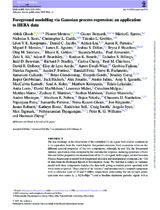| dc.contributor.author | Ghosh, Abhik | |
| dc.contributor.author | Mertens, Florent | |
| dc.contributor.author | Bernardi, Gianni | |
| dc.date.accessioned | 2021-02-15T08:34:00Z | |
| dc.date.available | 2021-02-15T08:34:00Z | |
| dc.date.issued | 2020 | |
| dc.identifier.citation | Ghosh, A. et al. (2020). Foreground modelling via Gaussian process regression: an application to HERA data. Monthly Notices of the Royal Astronomical Society, 495(3), 2813–2826 | en_US |
| dc.identifier.issn | 1365-2966 | |
| dc.identifier.uri | https://doi.org/10.1093/mnras/staa1331 | |
| dc.identifier.uri | http://hdl.handle.net/10566/5919 | |
| dc.description.abstract | The key challenge in the observation of the redshifted 21-cm signal from cosmic reionization is its separation from the much brighter foreground emission. Such separation relies on the different spectral properties of the two components, although, in real life, the foreground intrinsic spectrum is often corrupted by the instrumental response, inducing systematic effects that can further jeopardize the measurement of the 21-cm signal. In this paper, we use Gaussian Process Regression to model both foreground emission and instrumental systematics in ∼2 h of data from the Hydrogen Epoch of Reionization Array. | en_US |
| dc.language.iso | en | en_US |
| dc.publisher | Oxford University Press | en_US |
| dc.subject | Instrumentation: interferometers | en_US |
| dc.subject | Methods: statistical | en_US |
| dc.subject | Dark ages | en_US |
| dc.subject | Reionization | en_US |
| dc.subject | First stars | en_US |
| dc.title | Foreground modelling via Gaussian process regression: an application to HERA data | en_US |
| dc.type | Article | en_US |

